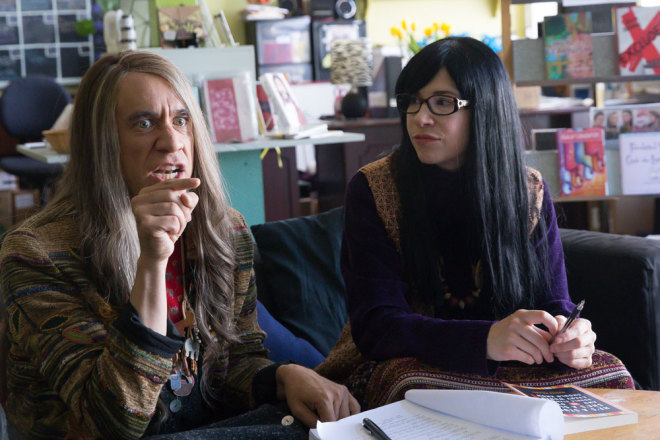Portlandia isn’t just about Portland (Or “Millennials.” Or “hipsters.”) It’s about paradoxes. From the inefficiencies of recycling to the side effects of vegan diets, it’s a show about how entitled people blindly adopt trends with only the best intentions, then fall short to an absurd degree. It’s a satire, but it’s not that far off from reality.
Co-creators Fred Armisen (SNL) and Carrie Brownstein (Sleater-Kinney) perform various recurring roles in the sketch comedy series with similar accuracy; whether feminist bookstore owners or goth couples, they nail almost every persona from demeanor to dialogue.
And the attention to detail doesn’t stop with the cast: In the director’s cut of “Brunch Village” at the end of Season 2, director Jonathan Krisel sets out to find the perfect “marionberries” to use as props, delaying filming and stressing out his crew. If the show’s about anything, it’s folks who get bogged down in details, and can’t see the forest for the marionberries. (Cameos by SNL players, Pitchfork-endorsed musicians, and even Roseanne Barr mean that even if this show doesn’t have something for everyone, it probably has someone.)
If you’ve caught some episodes of Season 5 on IFC this winter, don’t wait for Seasons 6 and 7. Toni and Candace’s origin story is funnier after you’ve known them through four seasons. And some of the best episodes are from Seasons 2 and 3. So put a bird sticker on all of your possessions, hang up some bad art on your good walls, and make sure your Mind-Fi connection is working.


IFC
Portlandia
Number of Seasons: 5 (47 episodes)
Time Requirements: Forty-seven 22-minute episodes total to about 17 hours of TV. Season 5 isn’t widely available for streaming yet, so that knocks it down to 37 (13.5 hours). You could do that in a day. But to be safe, give it two weeks at three or four episodes per day.
Where to Get Your Fix: Netflix, Amazon Prime, iTunes, Google Play, IFC.com (for Season 5 with some cable subscriptions).
Best Character to Follow:
Peter and Nance. Since Carrie and Fred come as a packaged duo in this show, so do their characters. Peter and Nance are nicey-nice, aging yuppies bound together almost as much by their shared timidity as by love. (Fellow insufferable couples will strongly relate.) The show’s writers seem to enjoy plopping the anxious, often insufferable couple into just about any situation, and the ensuing variation makes the recurrence feel less like re-runs than reunions. (In contrast, Dave and Kath’s act of monopolizing public spaces and wearing matching PJs gets old fast.)
Seasons/Episodes You Can Skip:
Because it’s a sketch series, it’s hard to get lost; even if a given episodes alludes to a previous one, it’s rarely disorienting. That said, it’s hard to find an episode that doesn’t have at least one or two segments to make the rest of the 22 minutes worth sitting through.
Season 2: Episode 7, “Motorcycle”
The last third is worth watching, but that’s about it. Claire hires an elderly woman (the sassy Ellen Bloodworth) to babysit Doug while she’s out. Later, Peter has some trouble remembering 9/11. (Said no one ever.)
Season 3: Episode 4, “Nina’s Birthday”
Armisen as Nina is great, especially when yelling “cacao!” (see: “Episodes You Can’t Skip”), but most of this episode isn’t. It’s no wonder Lance doesn’t show up to the party. Skip to watch 5:50-7:10 and 9:10-11:25 for the birthday loan officer, played by master of deadpan Kumail Nanjiani (Silicon Valley). Or just watch it here.
Season 3: Episode 11, “Blackout”
Bill Hader makes a Birdman appearance, but this season was shot in 2012, so it has nothing to do with the Michael Keaton film. Silliness + errings on the side of plot development rather than satire = skippable. I’d rather watch a never-ending string the show’s 30-second one-offs than go on another Walkabout.
Seasons/Episodes You Can’t Skip:
The show’s opening montage is a treat every time, from the Instagram-esque filtered footage of Portland to the perfect accompaniment by the Washed Out song “Feel It All Around.” Time is precious, we know, but treat yourself to the opening sequence every time.
Season 1: Episode 2, “A Song for Portland”
This is the first time we meet Nina and Lance, and Armisen is hilariously effective in drag as a whiny girlfriend. (Brownstein with a mustache and creepy down-pitched voice? Not so much.) Aubrey Plaza makes a cameo at Women and Women First, the feminist bookstore, and Armisen sports fake ear gauges. Also the episode with the show’s flagship “put a bird on it!” sketch.


IFC
Season 2: Episode 3, “Cool Wedding”
Weddings are the hardest thing to innovate, Spyke and Iris find upon planning theirs. Everything’s been done before (but not death and divorce!). One of those colorful parachutes from gym class is involved. Iris (Brownstein) yells at her friend Shannon – don’t miss it. Jack McBrayer forgets his reusable bag. A snobbish postal worker delivering Netflix DVDs escapes his role when one homeowner on his route watches a certain “film.”
Season 2: Episode 6, “Cat Nap”
“Two Girls Two Shirts” captures the short-sighted entrepreneurial spirit of Portlandians. Later: classic Kristin Wiig being Kristen Wiig as “Gathy,” a groupie for a new band featuring Kevin the Siamese cat. Keep your ears peeled for a jab at Sigur Ros. (Skip bike movers and “she’s making jewelry now,” if you’re fast-tracking your binge.)
Season 2: Episode 8, “Feminist Book Store 10th Anniversary”
One of the funniest sketches leads this episode: Twins Marcus and Madeline Harris educating Portland residents about “all the new recycling bins!” No discarded item is left out from the new color-coded bin system. Also, Peter and Nance appear in one of their silliest skits, which pretty much just feels like Armisen and Brownstein trolling us. “Byaaaaay!”
Season 3: Episode 3, “Missionaries”
Perhaps the best single-episode distillation of the series. You get a mockery of organic products (or two) ending abruptly amid awkwardness (the best kind of ending), along with Armisen making noises. A house meeting of Seattle roommates takes place, complete with a Kurt Cobain shrine and a “queen” (two fixtures of every community house). Things are rounded out by a white people’s dinner party and a nod to Portland’s dog population.
Season 3: Episode 5, “Squiggleman”
Well-intentioned hipster parents produce music for their preschoolers when the school library’s offerings aren’t good enough. The material they come up hits the sweet spot between ridiculous and realistic—and with a little help from Squiggleman, kid critics approve. The Portland Milk Advisory Board is getting old (and it’s not going anywhere), but luckily the clip is short. There’s also a guy named Wrick, which is about as plausible as having a smooth visit to the DMV.
Season 4: Episode 1, “Sharing Finances”
In an era where opening a joint checking account is akin to putting a ring on it, Claire and less-financially viable Doug agree to make the leap—but SNL‘s Vanessa Bayer is skeptical. One sketch is especially grating until you meet “Kermit the Bag.” Also, ghosts that cite left-leaning publications haunt a Portland home.


IFC
Why You Should Binge:
The show is hard to get into. The characters are annoying (that’s intentional, by the way). At first, it’s hard to keep Skype and Iris, Candace and Toni, Peter and Nance, Michelle and Brendan, Dave and Kath, Alicia and Royce (that’s her boss), Doug and Claire, Lance and Nina, and plain old Fred and Carrie straight. But it quickly becomes easier to pick up different characters’ nuances. You’ll start to notice throughlines; as the show goes on, plot matters more. Some of the best episodes are early in the show, and they’re the exposition that will prime you to plow through the rest. You’ll pick up little gems, like how this song pops up in all the right moments.
Also, the more Portlandia you watch, the more difficult it will become to distinguish what’s the show and what’s real. Which thankfully gives you the perspective to make real-life absurdities (e.g. organic foods market cashiers with leather jackets and beaded necklaces) that much more entertaining.
Best Scene:
Fred and Carrie (as Doug and Claire) get hooked on Battlestar Galactica (maybe they could have used our binge guide). After finishing every DVD, they’re still not satisfied, and in the characters’ usual misguided manner, they overreact, then brainstorm a way to take matters into their own hands to fulfill their desires.
The Takeaway:
“Portland is a city where young people go to retire,” Fred Armisen (as “Jason from LA”) explains. The adults who live there are sheltered and gullible. They skateboard instead of playing golf. They’re also self-righteous and independent. And if they’re not, they have babysitters—or parents.
If You Liked Portlandia You’ll Love:
If sketch comedy is your thing, try Little Britain. (Matt Lucas makes cameos in a couple of Portlandia episodes.) Key and Peele is another good bet. For eccentric characters in bite-size doses, The Office, Parks and Recreation, or 30 Rock all do the trick.